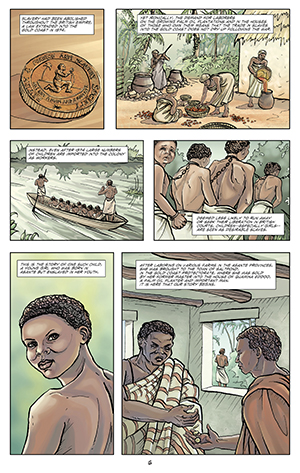Historian's graphic novel wins national award
"Abina and the Important Men," a graphic novel by Professor of History Trevor Getz based on the true story of an escaped slave who took her former master to court, has won the James Harvey Robinson Prize from the American Historical Association.

"Abina and the Important Men," a page of which is shown above, tells the story of an escaped slave in West Africa who takes her former master to court.
The prize is given every other year for the teaching aid that has made the most outstanding contribution to the teaching and learning of history for public or educational purposes. Getz, who also serves as chair of SF State's Academic Senate, will accept the award at the AHA's annual meeting in January.
"It's a wonderful honor," Getz said. "The goal of the book was to impact the teaching of history and help the discipline grow. I don't think there could have been a more meaningful award for it to receive."
Published in 2011 with illustrations by Liz Clarke, "Abina and the Important Men" depicts the life and trial of Abina Mansah, a woman living in 19th-century colonial West Africa who escapes slavery and takes her former master to court. Getz stumbled upon Mansah's story when looking through court transcripts in Ghana while researching his dissertation and knew immediately that he needed to tell the story of this woman who refused to retreat into the shadows of history. To reach a wider audience, he decided to do so through a graphic novel, believing that text and images together could be more powerful than words alone.

Professor of History Trevor Getz wrote "Abina" to challenge historians and students to think about who is depicted in history and how.
Designed as a teaching tool for historians and their students, the book raises questions about the process by which history is made, including who is represented and how; the use of different kinds of sources; and the relationship between history as an academic discipline and the way everyday people talk about the past. Included with the graphic novel are a reading guide, extensive historical context and the original court transcript, allowing readers to see how Getz's interpretation compares to the source material.
"In a very weird way, history is a tension between the subject who's being studied and the historian doing the work," he said. "I want students to think about our duty to write histories in which the people who are in them would recognize them. Would Abina recognize herself in this graphic history?"
Since its publication, "Abina" has sold more than 18,000 copies in North America, the UK, Australia, New Zealand, Japan and Brazil. It has been used in classrooms at 208 colleges and universities in the U.S. -- including in five classes at SF State -- and a number of high schools. A second edition, which provides a deeper exploration of gender issues presented in the book as well as a commentary from leading historians on whether Mansah was actually a slave, is planned for next year. An animated mobile version of the novel is also in the works.
For more information about "Abina and the Important Men" (Oxford University Press) including classroom resources for teachers, visit www.abina.org. Read the SF State News story on "Abina" at http://news.sfsu.edu/graphic-novel-raises-questions-about-making-history and the SF State Magazine article at http://www.sfsu.edu/~sfsumag/archive/fall_11/shadows.html